On 19 September the Group held its Annual General Meeting in our newly refurbished building in Belgrave Square. Immediately after the AGM it has now become traditional to have presentations from this year's David Miller Award winners. A summary of the presentations by Antje Fiebig and Sebastian Eves-van den Akker are presented below. In addition one of last year's winner, Amanda Hamilton, who delayed her use of the award until earlier this year described her visit to Tunisia to learn about their bioassay technique for aphid pathogenic bacteria.
In the same week we joined the Professional Horticulture Group South West for a visit to 'Desert and Jungle' and 'Top Plants', two contrasting Somerset nurseries. On October 15 we will be joining them again for a visit to Charlton Orchards near Taunton followed by a tour of Little Yarford Farmhouse.
Peter Grimbly
Contents
David Miller Travel Bursary Awards
From Apple to Brandy
Plant of the Month
News from our Associates
Horticulture Industry News
Events Calendar
Horticulture Group contact details
Related Links
David Miller Travel Bursary Awards
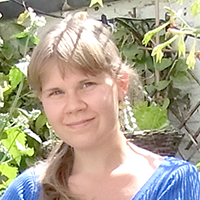
Antje is studying the feedback regulation of irrigation via soil moisture monitoring and its implication on plant growth and physiology. She had chosen to use her award as a contribution to her travel to Brisbane, Australia, to attend the 29th International Horticultural Congress organised by the International Society of Horticultural Science. She gave an oral presentation about her project and was pleased with the valuable comments and ideas for further research that she received. A paper including more detailed work, focusing not only on the feasibility of using soil moisture sensors for automatic irrigation scheduling, but also examinig the effects of deficit irrigation on possible tomato growth regulation through changes in leaf water status, gas exchange and plant hormone balance, will be published soon in an edition of Acta Horticulturae.
During the conference she was able to listen to other speakers and attend workshops on topics relevant to her work. Commenting on the experience she said 'I have obtained important and up-to-date information directly relevant to my work, which has also helped me think about additional experiments which might help to publish the data in high impact journals'.
A fuller report of her trip can be found here together with a link to her presentation to the Group.

Sebastian is trying to answer the question 'How can highly specialised endo-parasites have such broad host ranges?' He chose to use his award to attend the International Congress on Molecular Plant-Microbe Interactions in Rhodes, Greece in July 2014. His work focusses on parasitic nematodes and in particular the potato cyst nematode. He was able to give a presentation on this at the Congress. He found the trip an exceptional training experience and it directly resulted in numerous subsequent discussions. 'The breadth and quality of the research presented has helped to foster new ideas/directions in my own research and potential collaborations for future career opportunities.' he said, 'The ideas and knowledge acquired, made possible by the David Miller Travel Award, have been directly translated into current grant applications'.
A fuller report of his trip can be found here together with a link to his presentation to the Group.
From Apple to Brandy
The apple juice and cider industry has seen exceptional growth in recent years, albeit from small beginnings, as drinkers switch away from lager. And it is not just a UK phenomenon. The US has seen a similar rise in both products. These are two of the well-known by products of apples. Probably less well known is Calvados, the French apple Brandy created by distilling the cider apples of Normandy. Sadly almost unheard of is the English equivalent Somerset Cider Brandy.
Earlier this year we joined with the Professional Horticulture Group South West to see the production of this unique spirit. Buried in the heart of the Somerset cider apple orchards near the village of Kingsbury Episcopi, The Somerset Cider Brandy Company has been distilling cider since 1989. This was however the revival of a long tradition of cider distilling going back to at least the 17th century.
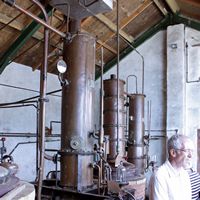
The Eau de Vie is then pumped into oak casks in their bonded warehouse. The choice of casks is very important to the eventual flavour of the brandy since it acquires much additional flavour from the wood. The usual barrels are made from American Oak (Quercus alba). These are favoured for the stronger flavours they impart. One particular cider brandy they produce, aptly named Shipwreck, is however from French Oak from the Allier region around Vichy. These casks were actually on their way to South Africa aboard the container ship Napoli when it became grounded in Lyme Bay and eventually broke up. With the permission of the Receiver of Wrecks, Julian ‘rescued’ the casks enabling him to produce his unique ‘Shipwreck’ cider brandy.
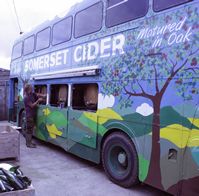
Amongst the other curiosities found around the orchard was an old double-decker bus (Pictured right) converted into a cider bar and at the time being prepared for a trip to the forthcoming Glastonbury Festival where it usually does a roaring trade.
Peter Grimbly
Plant of the Month
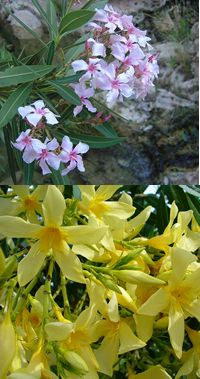
One of the most poisonous of all widely grown plants, the oleander is a member of the dogbane family (picture upper right by Rüdiger Meier). Also in this family is the very potent medicinal plant, Catharanthus roseus, the rosy periwinkle. Oleander is so widely grown across the Mediterranean, North Africa, Arabian Peninsula, and through to southern Asia that it is hard to know where it actually originates from.
Although not hardy in most of the UK, it grows well in large pots that can be overwintered inside. However, it is very commonly seen in gardens and on roadsides in warmer climes including California, Texas and across the Mediterranean.
This species is the only currently accepted one in the genus Nerium with a wealth of synonymy just to confuse the situation. There are also a large number of cultivars – a search in the RHS plant finder will return 197 results! Consequently there are a range of flower colours and forms available. (see lower right for example by Peter Forster)
The toxicity comes from the presence of cardiac glycosides – compounds in the same chemical class as digitoxin and digoxin from the common purple and woolly foxglove respectively. There are many interesting substances in oleander including one called oleandrin.
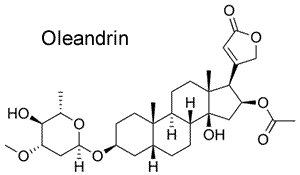
Oleandrin has been shown to inhibit the proliferation of various cancer cells. Human melanoma and leukaemia cells are more sensitive to this substance than normal human epithelial cells, peripheral blood mononuclear cells and so on, and so shows significant potential in cancer therapy.
Alison Foster
Oxford Botanic Garden
News from our Associates
Commercial Horticultural Association
CHA has now moved its Midlands office to a brand new facility located at the Rural Innovation Centre at Stoneleigh Park, Warwickshire in the heart of the UK. While they will retain their established head office (The White House, Brasted, Nr Westerham, Kent TN16 1JE), the new Stoneleigh office gives CHA an excellent and convenient central location. Their new address is: Commercial Horticultural Association, Rural Innovation Centre, Unit 169, Avenue H, Stoneleigh Park, Kenilworth, Warwickshire CV8 2LG
CHA is now recruiting for Growtech Eurasia held in Antalya, Turkey between 3-6 December 2014. For further information contact CHA.
Horticulture Innovation Partnership
HIP is jointly funding a Horticulture Knowledge Exchange Fellowship in partnership with the Research Councils (NERC and BBSRC). Anyone who might be interested in expanding their skills and experience working at the interface between academia and the fresh produce and potato industries particularly through knowledge exchange and research translation should apply. More details of the Horticulture Knowledge Exchange Fellowship are available on the NERC website.
Society of Biology
The Society responded to the review of the implementation of the Research Councils UK (RCUK) policy on open access. They presented an over-arching view of the landscape, focusing on three questions posed by the Review: the impact on learned societies; the effectiveness of the communication of the policy; and the impact on the wider OA landscape.
Horticulture Industry News
For the very latest horticultural news follow us on Facebook,
Twitter, or
LinkedIn
Seeds prepackaged with beneficial microbes
Plants have a symbiotic relationship with certain bacteria. These 'commensal' bacteria help the plants extract nutrients and defend against invaders. Now, scientists have discovered that plants may package their commensal bacteria inside of seeds; thus ensuring that sprouting plants are colonised from the beginning. The hypothesis behind this research is that the best way to defend against pathogenic contamination is with a healthy microbiome colonised by bacteria provide protection from invasive pathogens. Just as with babies, early colonisation is crucial to establishing a beneficial microbiome. The researchers looked inside sterilised mung beans and were able to isolate a unique strain of Bacillus pumilus that provides the bean with enhanced microbial protection. What they found was the new strain of Bacillus pumilus, a unique, highly motile Gram-positive bacterium capable of colonising the mung bean plant without causing any harm. Genome sequencing revealed that the isolated B. pumilus contained three unique gene clusters for the production of antimicrobial peptide compounds known as bacteriocins. More
Good vibrations control pests
Scientists in Northern Italy are experimenting with unusual and totally eco-friendly sound and odour devices to fight off insects from their cultivated fields. Their studies suggest that these methods could be as efficient in protecting crops as using chemical based pesticides. The European grape berry moth and the cicada are considered to be the major pests of cultivated grape. Commonly farmers use plant protection products like insecticides or plant growing regulators to protect their crops. The team, part of the EU research project PURE, have found ways to reduce the high pesticide rate in the European grapevine sector by disturbing the mating processes of the pests. The use of special vibrations and the odor of pheromones will in future help to prevent an offspring of the pests and this could reduce the use of pesticides close to zero.
A step towards increased crop photosynthesis
In photosynthetic organisms, d-ribulose-1,5-bisphosphate carboxylase/oxygenase (Rubisco) is the major enzyme assimilating atmospheric CO2 into the biosphere. Owing to wasteful oxygenase activity and slow turnover of Rubisco, the enzyme is among the most important targets for improving the photosynthetic efficiency of vascular plants. It has been anticipated that introducing the CO2-concentrating mechanism (CCM) from cyanobacteria into plants could enhance crop yield. However, the complex nature of Rubisco’s assembly has made manipulation of the enzyme extremely challenging, and attempts to replace it in plants with the enzymes from cyanobacteria and red algae have not been successful. Now two transplastomic tobacco lines with functional Rubisco from the cyanobacterium Synechococcus elongatus PCC7942 (Se7942) have been created. Both transformed lines were photosynthetically competent and their respective forms of Rubisco had higher rates of CO2 fixation per unit of enzyme than the tobacco control. These transplastomic tobacco lines represent an important step towards improved photosynthesis in plants. Now they need to add the remaining components of the cyanobacterial CCM mechanism. More
Trees have an individual bacterial identity
Each tree species has its own bacterial identity. That's the conclusion of researchers who studied the genetic fingerprints of bacteria on 57 species of trees growing on a Panamanian island. The study demonstrates for the first time that host plants from different plant families and with different ecological strategies possess very different microbial communities on their leaves. For the research they gathered bacterial samples from 57 of the more than 450 tree species growing in a lowland tropical forest. Using DNA sequencing technology they sequenced the bacterial 16S ribosomal RNA gene isolated from the samples. That gene, which biologists call a barcode gene, allowed researchers to identify and measure the diversity of bacteria based on millions of DNA fragments produced from bacterial communities collected from the surfaces of leaves. Some bacteria were very abundant and present on every leaf in the forest, while others were rare and only found on the leaves of a single host species. Each tree species possessed a distinctive community of bacteria on its leaves.
Speeding the search for disease
Using portable equipment called a ‘Smartcycler’, scientists and inspectors can now take samples of potentially infected trees and test them for the presence of the fungus, getting the results back in just over an hour. The Smartcycler is operated using a computer and is about the size of a large car battery, weighing about 10kg. The technology, originally developed in the US for detecting biological agents in the battlefield, was adapted by Fera for the detection of plant pathogens. Fera (Food and Environmenr Research Agnecy) initially used the machine to detect Phytophthora ramorum (the organism responsible for Sudden Oak Death). Fera’s scientists are also trialling the very latest in portable plant health diagnostic equipment at ash dieback sites. This technology represents the next generation field diagnostics. Working with UK company Optigene, the scientists have developed a machine that is even smaller and faster than the Smartcycler. This new machine, currently being tested at outbreak sites, will reduce the time taken to get results still further – to less than 30 minutes. The new machine, called the Genie II only weighs about 2kg and uses the latest techniques in rapid DNA analysis.
How Caffeine Evolved
Despite our huge appetite for caffeine scientists know little about how and why plants make it. A new study is helping to change that. By analysing its genes, scientists were able to reconstruct how coffee gained the biochemical equipment necessary to make caffeine. The new study sheds light on how plants evolved to make caffeine as a way to control the behavior of animals—and, indirectly, us. Caffeine starts out in coffee plants as a precursor compound called xanthosine. An enzyme then chops off a dangling arm of atoms from the xanthosine and other enzymes add three additional clusters of atoms. Once the process is complete, they’ve turned xanthosine into caffeine. Caffeine was also made in other plants, like tea and cacao, by N-methyltransferases. But by sequencing the coffee genome the team were able to make a more detailed comparison of the genes in different species. They discovered that in cacao, the enzymes manufacturing caffeine did not evolve from the same ancestors as those in coffee. In other words, the coffee plant and cacao plant took different evolutionary paths to reach the same destination. More & More
Elliot review published
Professor Chris Elliott’s final report into the integrity and assurance of UK food supply networks was published on 4 September 2014. You can download the report at the following link. The review was prompted by growing concerns about the systems used to deter, identify and prosecute food adulteration. The horse meat crisis of 2013 was a trigger, as were concerns about the increasing potential for food fraud and food crime. Food fraud becomes food crime when it no longer involves random acts by rogues within the food industry but becomes an organised activity by groups which knowingly set out to deceive, and or injure, those purchasing food. These incidents can have a huge negative impact both on consumer confidence, and on the reputation and finances of food businesses. The Department for Environment, Food and Rural Affairs has also published its response. More
Events Calendar
National Fruit Show
15 - 16 Oct 2014
Detling, UK
Grapevine Roots
16 - 17 Oct 2014, International Society for Horticultural Science
Rauscedo, Italy
Biocontrol Industry Meeting
20 - 22 Oct 2014
Basel, Switzerland
Implementing the UK Agricultural Technologies Strategy
23 Oct 2014, Westminster Food & Nutrition Form
London, UK
Global Plant Health
27 - 28 Oct 2014, Fera
York, UK
Developments in hand-held application techniques
28 - 29 Oct 2014, Association of Applied Biologists
Barcelona, Spain
BCPC Weeds Review 2014
13 Nov 2014, BCPC
Harpenden, UK
Advances in IPM
19 - 20 Nov 2014, Association of Applied Biologists
Marston, UK
Croptec
19 - 20 Nov 2014
Peterborough, UK
Crop Production in Southern Britain: Precision Decisions for Profitable Cropping
25 - 26 Nov 2014, Association of Applied Biologists
Peterborough, UK
Postharvest Research, Education and Extension
8 - 11 Dec 2014, International Society for Horticultural Science
Hochiminh City, Vietnam
Challenges for Crop Production and Quality
9 - 10 Dec 2014, Association of Applied Biologists
Harpenden, UK
Teaching and Communicating Science in the Digital Age
15 - 17 Dec 2014, Society of Experimental Biology
London, Uk
Advances in Nematology
16 Dec 2014, Association of Applied Biologists
London, UK
If you would like to advertise a forthcoming event please contact. ester.monfort@soci.org
Horticulture Group Contact Details
For submitting ideas or to volunteer to be part of a committee or a group, please contact:
Chairman - Peter Grimbly
Meetings Secretary - Alison Foster
Minutes Secretary - Margaret Waddy
Newsletter co-ordinator - Sue Grimbly scihortigroup@btinternet.com
Group Contact - Ester Monfort Martinez, E: ester.monfort@soci.org T: +44(0)20 7598 1584
